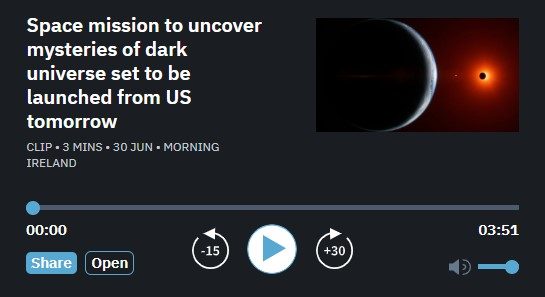Euclid's six year space mission
Toggle
The European space telescope's mission is to survey the dark universe and probe the nature of dark matter and dark energy, writes Prof Peter Coles, Department of Theoretical Physics
 Last weekend, a Falcon 9 rocket operated by SpaceX blasted off from the Kennedy Space Center at Cape Canaveral in Florida. On board was Euclid, an ambitious space telescope that will be used over its six-year mission to map the distribution of distant galaxies over about one-third of the sky.
Last weekend, a Falcon 9 rocket operated by SpaceX blasted off from the Kennedy Space Center at Cape Canaveral in Florida. On board was Euclid, an ambitious space telescope that will be used over its six-year mission to map the distribution of distant galaxies over about one-third of the sky.
The aim is to use these measurements to find out more about the constituents of the universe, and test whether our current ideas about cosmic evolution are correct.
Euclid – named after the ancient Greek mathematician who is considered to be the father of geometry – has been more than a decade in the making. The idea of a space mission to do what Euclid is going to do dates back about 20 years, but it was not until 2013 that the detailed design was formally adopted by the European Space Agency (ESA) as a component of its science programme.
The launch was planned for 2019 on a Russian Soyuz spacecraft. After a delay caused by the Covid-19 pandemic, the war in Ukraine led to the termination of the agreement with Soyuz and a further long delay to Euclid looked inevitable. Fortunately, ESA managed to secure an agreement with SpaceX that got everything back on track for launch last weekend.
The Euclid mission is very complex. The consortium behind it consists of over 2,500 scientists, engineers and software specialists spread over more than 200 different laboratories worldwide in more than 15 countries. At the Euclid Consortium annual meeting in Oslo last year, not long after the Russian invasion of Ukraine, and the cancellation of the Soyuz contract, the atmosphere was gloomy. The 2023 meeting in Copenhagen last month, with the launch imminent, could not have been more different.
Ireland is not officially a Euclid member state. In fact, I am the only member of the Euclid Consortium based here. I joined Euclid when working in the UK (which is a Euclid member state) but was allowed to continue as a member when I moved here in 2017.
It is perhaps interesting to compare Euclid with another recently-launched high-profile space telescope, the James Webb Space Telescope (JWST) which was launched on Christmas Day 2021. Euclid is a much smaller telescope – 1.2m diameter instead of 6.5m – which means that it is a smaller payload. In ESA lingo, Euclid is just an 'M’ (Medium) class mission. That doesn’t mean it is cheap. The budget is around €1.4 billion, but it’s cheaper than JWST which cost over $10 billion.
But size isn’t the main difference between these two space telescopes. They are designed to do very different things. The huge collecting area of the JWST mirror makes it excellent for observing very faint objects at high resolution, but it has a relatively narrow field of view. Euclid is not so sensitive so will not see so far out into space, but its instruments are better designed for making high-quality maps over a large part of the sky. While JWST is operated in a similar way to traditional observatories (it's multi-purpose and can be pointed anywhere on the sky), Euclid is a dedicated survey instrument that will scan a particular region of the sky systematically over the lifetime of the mission.
Our current theoretical model of the Universe is extremely successful at accounting for most of what we can observe with current facilities. To make it work, we have to infer the presence of not one but two mysterious ingredients we know little about. One is dark matter, material which does not interact directly with light (or any other form of radiation) but exerts a gravitational field. The other is dark energy, introduced by Einstein in his original theory of cosmology back in 1917, that can cause the expansion of the Universe to speed up, as observations suggest it is doing.
There are two main ways in which Euclid measurements can be used to study these ingredients. The first is to look at the way images of distant galaxies are distorted as the light travelling from them to the Euclid telescope interacts gravitationally as it travels through dark matter along the line of sight; this is called weak gravitational lensing.
The second method is to examine the clustering of the galaxies in the Euclid field, which we expect to carry the faint imprint of acoustic oscillations generated in the early Universe – a weak signal in the noise generated by the Big Bang. These have been detected using ground-based surveys but Euclid will obtain much more precise information about how their strength varies with cosmic epoch.
Using these two methods, and a battery of auxiliary information, Euclid should provide a precise assessment of the status of our theory of the Universe. It will take many months from launch for Euclid’s instruments to be tested and calibrated, and it will take at least two years for the first preliminary data to be released, so don’t expect any immediate results. Will Euclid confirm what we think about dark matter and dark energy, or will it show we need to overhaul our ideas of cosmology? Only time (and space) will tell!
This article originally appeared on RTÉ Brainstorm

The aim is to use these measurements to find out more about the constituents of the universe, and test whether our current ideas about cosmic evolution are correct.
Euclid – named after the ancient Greek mathematician who is considered to be the father of geometry – has been more than a decade in the making. The idea of a space mission to do what Euclid is going to do dates back about 20 years, but it was not until 2013 that the detailed design was formally adopted by the European Space Agency (ESA) as a component of its science programme.
The launch was planned for 2019 on a Russian Soyuz spacecraft. After a delay caused by the Covid-19 pandemic, the war in Ukraine led to the termination of the agreement with Soyuz and a further long delay to Euclid looked inevitable. Fortunately, ESA managed to secure an agreement with SpaceX that got everything back on track for launch last weekend.
The Euclid mission is very complex. The consortium behind it consists of over 2,500 scientists, engineers and software specialists spread over more than 200 different laboratories worldwide in more than 15 countries. At the Euclid Consortium annual meeting in Oslo last year, not long after the Russian invasion of Ukraine, and the cancellation of the Soyuz contract, the atmosphere was gloomy. The 2023 meeting in Copenhagen last month, with the launch imminent, could not have been more different.
 |
From RTÉ Radio 1's Morning Ireland, Prof Peter Coles on the Euclid space mission. |
Ireland is not officially a Euclid member state. In fact, I am the only member of the Euclid Consortium based here. I joined Euclid when working in the UK (which is a Euclid member state) but was allowed to continue as a member when I moved here in 2017.
It is perhaps interesting to compare Euclid with another recently-launched high-profile space telescope, the James Webb Space Telescope (JWST) which was launched on Christmas Day 2021. Euclid is a much smaller telescope – 1.2m diameter instead of 6.5m – which means that it is a smaller payload. In ESA lingo, Euclid is just an 'M’ (Medium) class mission. That doesn’t mean it is cheap. The budget is around €1.4 billion, but it’s cheaper than JWST which cost over $10 billion.
But size isn’t the main difference between these two space telescopes. They are designed to do very different things. The huge collecting area of the JWST mirror makes it excellent for observing very faint objects at high resolution, but it has a relatively narrow field of view. Euclid is not so sensitive so will not see so far out into space, but its instruments are better designed for making high-quality maps over a large part of the sky. While JWST is operated in a similar way to traditional observatories (it's multi-purpose and can be pointed anywhere on the sky), Euclid is a dedicated survey instrument that will scan a particular region of the sky systematically over the lifetime of the mission.
Our current theoretical model of the Universe is extremely successful at accounting for most of what we can observe with current facilities. To make it work, we have to infer the presence of not one but two mysterious ingredients we know little about. One is dark matter, material which does not interact directly with light (or any other form of radiation) but exerts a gravitational field. The other is dark energy, introduced by Einstein in his original theory of cosmology back in 1917, that can cause the expansion of the Universe to speed up, as observations suggest it is doing.
There are two main ways in which Euclid measurements can be used to study these ingredients. The first is to look at the way images of distant galaxies are distorted as the light travelling from them to the Euclid telescope interacts gravitationally as it travels through dark matter along the line of sight; this is called weak gravitational lensing.
The second method is to examine the clustering of the galaxies in the Euclid field, which we expect to carry the faint imprint of acoustic oscillations generated in the early Universe – a weak signal in the noise generated by the Big Bang. These have been detected using ground-based surveys but Euclid will obtain much more precise information about how their strength varies with cosmic epoch.
Using these two methods, and a battery of auxiliary information, Euclid should provide a precise assessment of the status of our theory of the Universe. It will take many months from launch for Euclid’s instruments to be tested and calibrated, and it will take at least two years for the first preliminary data to be released, so don’t expect any immediate results. Will Euclid confirm what we think about dark matter and dark energy, or will it show we need to overhaul our ideas of cosmology? Only time (and space) will tell!
This article originally appeared on RTÉ Brainstorm
